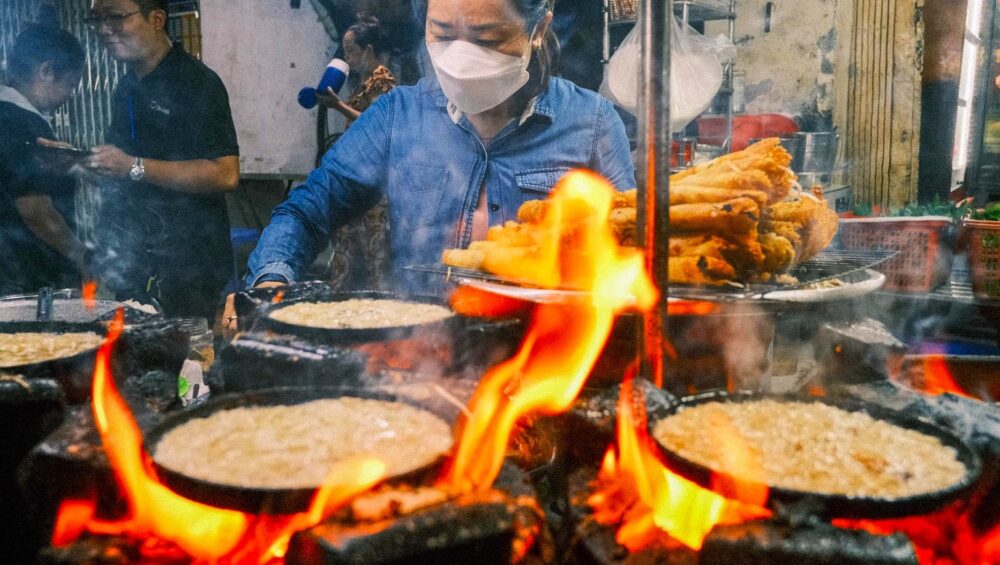Vietnam is not only renowned for its stunning landscapes, long beaches, majestic terraced fields, and rich historical sites—it’s also known as a street food paradise. On nearly every street corner, sidewalk, or alleyway, travelers can find tantalizing dishes packed with local flavor, offering an authentic reflection of Vietnamese culture and lifestyle. Joining a street food tour in Vietnam is one of the best ways to explore not just the cuisine, but the very soul of this vibrant country.
A Unique Experience Through Street Food Tours
Street food tours across Vietnam are becoming increasingly popular among international travelers. These tours go beyond simply eating delicious food—they offer a glimpse into the daily life of local people.
Visitors walk through old quarters, small alleys, and traditional markets where local life unfolds vividly. In addition to tasting iconic dishes, guests often have the chance to learn how to cook these meals with guidance from local residents.
Most tours take place in the evening—when Vietnam’s streets come alive. As the sun sets and golden lights flicker on, food stalls buzz with activity. The sizzling sound of frying pans, the aroma of spices, and the lively chatter all combine to create an immersive experience.
Why Vietnamese Street Food Tours Are So Appealing
- Discover traditional flavors: Guests sample signature Vietnamese dishes—from hearty meals to snacks and unique beverages.
- Learn about local culture: Each dish reflects regional customs, traditions, and ways of life.
- Enjoy authentic settings: Eating on sidewalks, in night markets, or at humble street stalls offers an intimate look into local living.
- Participate in cooking: Some tours include cooking classes for traditional dishes like fresh spring rolls, pho, or banh xeo (crispy pancakes).
- Taste regional diversity: From North to South, each area boasts a distinct culinary style—mild and balanced in the North, bold and spicy in the Central region, and sweet and vibrant in the South.
- Try local drinks: Iced milk coffee, sugarcane juice, sweet soups, and fruit smoothies are essentials in any culinary journey.
Street Food – A Cultural Heritage of Vietnam
Street food is more than just a part of Vietnamese cuisine—it’s the soul of everyday life. Visitors who wander through Vietnam’s alleys are instantly immersed in this dynamic culinary culture. The sizzling sounds, fragrant herbs, and bold seasonings all come together in an unforgettable experience.
Historical Roots
Vietnamese street food has been around for thousands of years, closely tied to traditional markets where people gather to trade and socialize. Over time, it has absorbed influences from Chinese, French, and Khmer cuisines, while preserving its unique identity.
A Way of Life
Street food in Vietnam is not just tasty and affordable—it’s a social space. Morning routines often include bowls of pho or bún, and sidewalk coffee gatherings are a daily ritual for many locals.
Comparison with Other Asian Street Foods
Vietnamese street food is known for its balance of flavors: sweet, sour, salty, and spicy. It’s less fiery than Thai food and milder in aroma compared to Malaysian dishes. Fresh herbs and refined dipping sauces are defining features of Vietnamese culinary finesse.
Top Cities for Street Food Tours
- Hanoi: Old Quarter streets like Ta Hien and Hang Buom are ideal for tasting pho, bun cha, banh cuon, and egg coffee.
- Ho Chi Minh City: Ben Thanh Market and Bui Vien Street are packed with Southern favorites like com tam, hu tieu, and rice paper salad.
- Hoi An: Its night markets offer specialties such as cao lau, banh xeo, and local sweet soups.
- Hue: Streets like Nguyen Dinh Chieu and Nguyen Thai Hoc are known for bun bo Hue, banh beo, and com hen (clam rice).
- Da Lat, Nha Trang, Phu Quoc: Their night markets feature coastal and mountain delicacies.
- Can Tho & the Mekong Delta: Floating markets and rustic dishes like banh cong and banh xeo are highlights here.
Popular Street Food Tour Formats
Visitors can choose from a variety of formats:
- Walking tours: Perfect for exploring Old Quarters in Hanoi or Hoi An on foot.
- Motorbike tours: More flexible, covering a wider range of food spots in less time.
- Cooking combo tours: After sampling, guests take part in cooking classes to learn how to prepare Vietnamese dishes themselves.
Cost and Duration
Street food tours typically cost between 400,000 and 1,500,000 VND (approximately 15–60 USD), depending on length and format. Most tours last 2–4 hours and include a guide, food, drinks, and experiences. Many companies also offer private or vegetarian-friendly tours.
Highlight Street Foods by Region
Northern Vietnam
- Pho Hanoi: Clear, delicate broth with soft noodles.
- Bun cha: Grilled pork served with fresh noodles and sweet-sour fish sauce.
- Banh cuon Thanh Tri: Thin, soft rice rolls filled with minced pork.
Central Vietnam
- Bun bo Hue: Spicy beef noodle soup with fermented shrimp paste and lemongrass.
- Mi Quang: Turmeric noodles served with rice crackers and fresh herbs.
- Cao lau (Hoi An): Thick noodles, pork slices, and local greens.
Southern Vietnam
- Com tam: Broken rice with grilled pork, fried egg, and pickles.
- Hu tieu Nam Vang: Savory noodle soup with pork, shrimp, and quail egg.
- Banh trang tron: A tangy and spicy rice paper salad popular among youth.
Must-Try Street Beverages
- Iced milk coffee (cà phê sữa đá): Rich and sweet, an icon of Vietnamese coffee culture.
- Sugarcane juice (nước mía): Refreshing and often mixed with kumquat.
- Chè (sweet soup): A wide variety from mixed bean dessert to pomelo and mung bean.
- Fruit smoothies: Fresh, chilled, and perfect for the tropical climate.
Dining Etiquette & Cultural Respect
Street food is not just about eating—it’s cultural appreciation. When joining food tours, visitors should keep in mind:
- Don’t tap chopsticks on bowls or stick them upright in rice.
- Use personal chopsticks for communal dishes.
- Greet and thank the vendor after your meal.
- Finish your portion as a sign of respect.
- Elders are usually invited to eat first.
Best Time to Enjoy Vietnamese Street Food
Every season offers something special. In summer, chè and smoothies are crowd favorites. In fall and winter, grilled dishes, hot pots, and noodle soups take the spotlight. Food festivals like the “Hoi An International Food Festival” are perfect opportunities to savor regional culinary excellence.
In conclusion, a street food tour is one of the most fulfilling ways to experience Vietnamese culture. Visitors not only indulge in tasty dishes, but also connect with the local rhythm of life, meet warm-hearted people, and bring home memories to last a lifetime.




